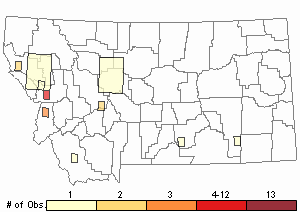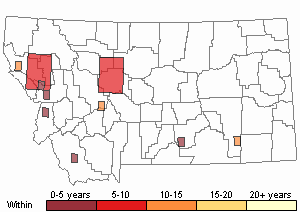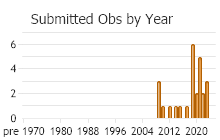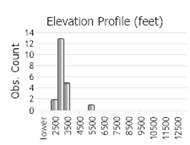View in other NatureServe Network Field Guides
NatureServe
Montana
Utah
Wyoming
Idaho
Wisconsin
British Columbia
South Carolina
Yukon
California
New York
Montana Six-plume Moth - Alucita montana
General Description
The Montana Six-plume Moth (
Alucita montana) is in the "many-plume moth" family
Alucitadae. The "many-plume moths" are so called because the wings are deeply cleft to the basal forks of the veins, so each wing has six fringed plume-like segments. The adult Montana Six-plume Moth is small (forewing 5.5-6.5 mm), pale grey with faint, transverse banding of dark brown and tan, more distinct on the forewing, especially the costal edge. They are unmistakable by their wing structure. The Montana Six-plume Moth larvae has a stout body with short legs, and short setae on inconspicuous pinacula (Powell and Opler 2009).
Two new species of Alucita were described by Bernard and Jean-François Landry in 2004, bringing the North American species total to three. The Eurasian species, Twenty-plume Moth (Alucita hexadactyla), was previously thought to be the only species of Alucita in North America. Landry and Landry have since determined that the Twenty-plume Moth does not occur in North America (McLeod 2006).
Phenology
The Montana Six-plume Moth is widespread and commonly encountered, often in winter when the moths hide under loose bark, in wood piles, and in buildings. The adults fly in spring and again in late summer or fall. Adults fly early in the evening or any time on cloudy days, and may sometimes be found in homes fluttering at windows. Because adults overwinter and populations occur in a wide range of elevations and latitudes there are collection records throughout the year (Powell and Opler 2009).
Diagnostic Characteristics
A. ariendenisi is similar to A. montana, but appreciably larger (forewing 6.5 - 8 mm) and darker colored with more distinct transverse bands. It ranges from New York across Canada to southern Northwest Territory (Landry and Landry 2004).
Range Comments
The Montana Six-plume Moth occurs in southeastern Canada and throughout the western provinces and states, except in desert regions, from central Alberta to western Texas (Powell and Opler 2009).
Observations in Montana Natural Heritage Program Database
Number of Observations: 26
(Click on the following maps and charts to see full sized version)
Map Help and Descriptions
Relative Density

Recency



 (Observations spanning multiple months or years are excluded from time charts)
(Observations spanning multiple months or years are excluded from time charts)
Food Habits
Montana Six-plume Moth larvae feed on
snowberry (
Symphoricarpos spp), probably as leaf or flower miners (Powell and Opler 2009).
Reproductive Characteristics
David Wagner collected cocoons of Montana Six-plume Moth on Round-leaf Snowberry (Symphoricarpos vaccinioides) at Lake Tahoe in early July, and adults emerged in August. The species may be univoltine (Powell and Opler 2009).
Stewardship Responsibility
References
- Literature Cited AboveLegend:
 View Online Publication
View Online Publication Landry, B., and J.F. Landry. 2004. The genus Alucita in North America, with description of two new species (Lepidoptera: Alucitidae). The Canadian Entomologist 136: 553-579.
Landry, B., and J.F. Landry. 2004. The genus Alucita in North America, with description of two new species (Lepidoptera: Alucitidae). The Canadian Entomologist 136: 553-579. Powell, J.A. and P.A. Opler. 2009. Moths of Western North America. University of California Press, Berkeley, CA. 369 pp.
Powell, J.A. and P.A. Opler. 2009. Moths of Western North America. University of California Press, Berkeley, CA. 369 pp.
- Web Search Engines for Articles on "Montana Six-plume Moth"
- Additional Sources of Information Related to "Insects"





